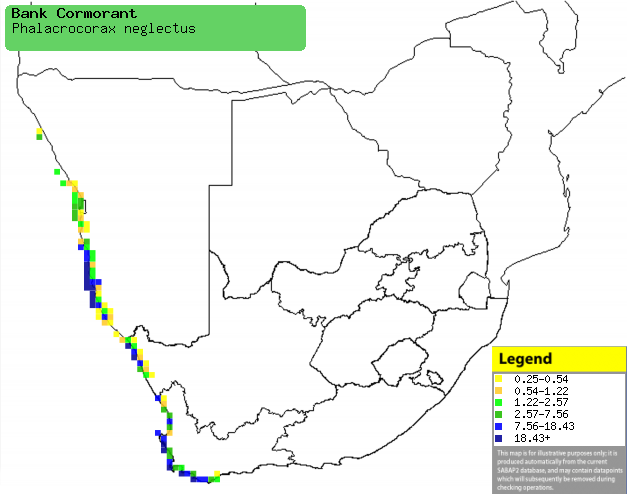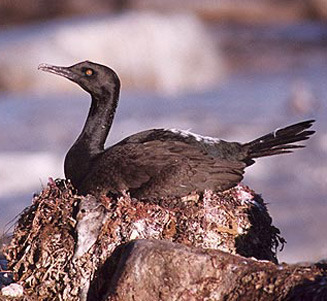Phalacrocorax neglectus (Bank
cormorant)
Bankduiker [Afrikaans]; Kustaalscholver
[Dutch]; Cormoran des bancs [French]; Küstenscharbe [German];
Corvo-marinho-dos-baixios [Portuguese]
Life
> Eukaryotes >
Opisthokonta
> Metazoa (animals) >
Bilateria >
Deuterostomia > Chordata >
Craniata > Vertebrata (vertebrates) > Gnathostomata (jawed
vertebrates) > Teleostomi (teleost fish) > Osteichthyes (bony fish) > Class:
Sarcopterygii (lobe-finned
fish) > Stegocephalia (terrestrial
vertebrates) > Tetrapoda
(four-legged vertebrates) > Reptiliomorpha > Amniota >
Reptilia (reptiles) >
Romeriida > Diapsida > Archosauromorpha > Archosauria >
Dinosauria
(dinosaurs) > Saurischia > Theropoda (bipedal predatory dinosaurs) >
Coelurosauria > Maniraptora > Aves
(birds) > Order: Ciconiiformes
>
Family: Phalacrocoracidae
Distribution and habitat
Endemic to southern Africa's western coast, from Namibia
down to the Northern and Western Cape. It generally stays close to the
coastline, especially within the kelp zone, rarely moving further out to sea.
|
 |
|
Distribution of Bank cormorant in southern Africa,
based on statistical smoothing of the records from first SA Bird Atlas
Project (©
Animal Demography unit, University of
Cape Town; smoothing by Birgit Erni and Francesca Little). Colours range
from dark blue (most common) through to yellow (least common).
See here for the latest distribution
from the SABAP2. |
Predators and parasites
- Predators
- Orcinus orca (Killer whale)
- Parasites
- conjunctivitis caused by Staphylococcus and Haemophilus.
Movements and migrations
Adults generally stay within roughly 10 km of
their breeding site, although juveniles disperse and travel much
longer distances after fledging.
Food
It eats fish and aquatic invertebrates, doing most of its foraging
alone among kelp beds, descending to the sea floor to catch slow-moving
bottom-dwellers. It dives in stints of 26-80 seconds, often descending to a
depth of at least 28 metres. The following food items have been recorded
in its diet:
- Fish
- Sufflogobius bibarbatus (Pelagic goby)
- Merluccius (hakes)
- Cancelloxus burrelli (Slender platanna klipfish)
- Gnathophis capensis (Southern conger)
- Chorisochismus dentex (Rock sucker)
- Gonorhynchus gonorhynchus (Beaked sandfish)
- Syngnathus acus (Southern conger)
- Sepia vermiculata (Common cuttlefish)
- flatfish
- Invertebrates
- Pterygosquilla armata (Cape mantis shrimp)
- Octopus (octopus)
- Jasus lalandii (West coast rock lobster)
- Plagusia chabrus (Cape rock crab)
- Parechinus angulosus (Cape urchins)
- Haliotis (abalones)
- H. parva
- H. middae
- H. chitons
Breeding
- Monogamous, typically nesting in colonies of 20-100 pairs, with the male
performing a display in which he throws head forward and backward
repeatedly.
- The nest is built by both sexes (see image below), consisting of a large
platform built largely of fresh seaweed with a few sticks and feathers. It
is typically placed on coastal islands, cliffs, boulders, walls, inshore
rocks or artificial platforms next to the sea.
 |
|
| Adult on nest. [photos H. Robertson, Iziko ©] |
|
- Egg-laying season is year-round, peaking from May-October in the Western
Cape and from November-April in Namibia.
- It lays 1-3 eggs, which are incubated by both sexes for about 28-32
days.
- The chicks start exploring the area around the nest at about 50 days
old, taking their first flight at 55-70 days old and becoming fully
independent roughly three months later.
Threats
Previously classified as Vulnerable, its status has
since worsened to Endangered, as its population has decreased by at least
50% in the last three generations. Its largest colony (on Ichaboe Island, Namibia)
is contracting in size due to a collapse in the stocks of Pelagic goby (Sufflogobius
pusillus). This combined with general food scarcity, human disturbance and
competition for space with Cape fur seals (Arctocephalus pusillus)
has been responsible for decreases in population on other islands and breeding
sites.
References
-
Hockey PAR, Dean WRJ and Ryan PG 2005. Roberts
- Birds of southern Africa, VIIth ed. The Trustees of the John Voelcker
Bird Book Fund, Cape Town.
|
